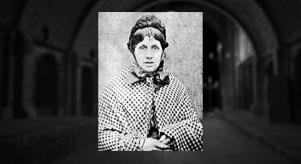
How a polygraph caught a killer, the Kate Prout case
Philip Glenister, who became a TV icon as the fist-flinging, no-nonsense, old school copper Gene Hunt, is on more thoughtful form in What the Killer Did Next – a show that looks at how real-life murderers behaved in the hours and days after they committed their crimes. One case in the series, the murder of Kate Prout, touches on a controversial tool in the arsenal of investigators: the polygraph, or ‘lie detector’.
When Kate Prout, a 55-year-old Gloucestershire woman, mysteriously vanished in 2007, suspicion fell on her estranged husband: wealthy businessman Adrian Prout. The problem was the lack of a body. Even after he was eventually sent down for the murder, Adrian had plenty of support from people who thought he was innocent, including his new partner Debbie Garlick, who fronted a very public campaign hinging on the motto, 'No body, no proof, no justice.'
But then, Adrian made the fateful, too-confident decision to take a lie detector test, which he spectacularly failed. The man running the test looked at Adrian and said, 'I’m looking at a murderer”. Not long after that, Adrian Prout devastated Debbie Garlick by telling her he was indeed guilty of Kate’s killing.
Job well done by the polygraph? Perhaps, but the accuracy of the contraption has been the subject of fierce debate ever since it was created by a pioneering police officer in California back in 1921. He was John Augustus Larson, who integrated different measurements – of heart rate, respiration and skin conductivity – to measure a person’s physiological reaction to certain questions. He was building on previous work done by William Moulton Marston, who’d theorized that fluctuations in blood pressure could show if somebody was lying. (William Moulton Marston would go on to create the iconic superhero Wonder Woman, who famously wields a 'lasso of truth')
Larson dubbed his device the 'cardio-pneumo psychogram', and it was first used to investigate a man called William Hightower, accused of killing a priest. A headline referencing the use of the test screamed 'Science Indicates Hightower’s Guilt', with the article itself saying: 'Science penetrated the inscrutable face of William A. Hightower today, revealed that beneath an unruffled exterior is a seething torrent of heart throbbing emotions and that these emotions indicate strongly that he was the murderer of Father Heslin of Colma.'
But this 1921 newspaper piece inadvertently highlights a troubling question which still dogs the polygraph process today: to what extent can an emotional response provide empirical evidence of guilt? A polygraph isn’t really a lie detector so much as it is a stress detector. Many things can cause stress – not least the whole process of being strapped into a polygraph, with sensors attached to your chest and fingers, and a stranger interrogating you about some heinous crime.
As psychologist and polygraph researcher Leonard Saxe puts it, 'There's no unique physiological sign of deception. And there's no evidence whatsoever that the things the polygraph measures — heart rate, blood pressure, sweating, and breathing — are linked to whether you're telling the truth or not.'
The polygraph process involves being given a series of questions – some of which are 'control questions' which don’t relate to the crime itself and provide a base-level anxiety response against which the interrogator can measure any sudden spikes of stress related to the crime-specific questions. The problem is, several factors can affect the process. For example, an innocent person may find crime-specific questions just as stressful as a liar. The interrogator also matters: their manner and the way they question the subject. The process has been likened to a poker game, with interrogators often bluffing and asking deliberately provocative questions to provoke a response.
Research was conducted by WIRED magazine into thousands of polygraph tests carried out by Washington State Patrol on potential recruits. It found that some interrogators failed a much higher proportion of candidates than others, with some failing one in 20 job-seekers for apparently lying about whether they’d had sex with animals. On top of that, the biases of the interrogator can come into play. Back in 1990, a study by the US Department of Defense showed that, during mock-crime investigations for trainees, black people were more likely to be incorrectly accused of deception than white people.
If the examiner... tricks the subject into believing that his or her lies can be detected, they might confess
A living indictment of polygraph testing is Aldrich Ames, a CIA agent who was given a whole-life sentence for leaking secrets to the Soviet Union. He effortlessly passed his polygraph tests, later revealing ‘there’s no special magic. Confidence is what does it.’ He also put his success down to getting a good sleep the night before and has dismissed polygraph testing as the worst kind of pseudoscience.
And, as former US intelligence officer George Maschke has said, plenty of techniques can be used to confuse the polygraph, such as biting the inside of one’s mouth or conjuring up stressful and exciting memories during the control questions
Yet, polygraphs can in ideal conditions be a useful tool for investigators. As psychologist Leonard Saxe says, they’re often utilized as a prop in the theatre of interrogation: ‘If the examiner does the theatre well, and tricks the subject into believing that his or her lies can be detected, they might confess.’ This could have been the reason why Adrian Prout eventually caved during his lie detector test, after years of denying he’d killed his wife.
Polygraphs have been vindicated in other cases too, such as the 2002 kidnapping and murder of young Daniele van Dam in San Diego. Her neighbour, David Westerfield, became the key suspect following a failed polygraph and was eventually convicted.
The opaque nature of the process means polygraph tests are not admissible as evidence in UK criminal courts, while in the US they are inadmissible in some states and allowed under certain conditions in others. That said, they’re widely used in the US to vet candidates for jobs in security, law enforcement and the public services. Here in Britain, they’re used to monitor convicted sex offenders to check they’re complying with terms of their release – such as not using the Internet or going to certain areas. Droves of sex offenders have been sent back to prison after failing tests. We’re now also on the cusp of a brave new world beyond conventional polygraphs, with new devices able to detect deception by tracking a person’s eye movements and pupil dilation – similar to the replicant test in the movie Blade Runner. So, ultimately, while the controversies about their accuracy will always persist, lie detectors are here to stay.




